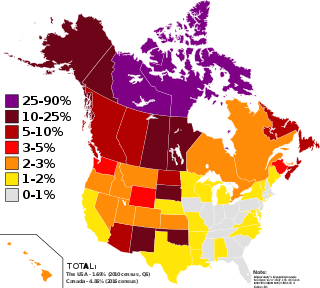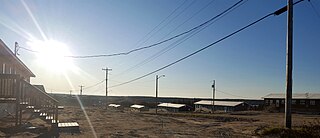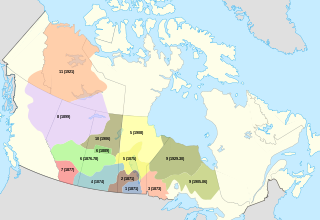
In Canada, indigenous groups comprise the First Nations, Inuit and Métis. Although Indian is a term still commonly used in legal documents, the descriptors Indian and Eskimo have fallen into disuse in Canada, and most consider them to be pejorative. Aboriginal peoples as a collective noun is a specific term of art used in some legal documents, including the Constitution Act, 1982, though in most Indigenous circles Aboriginal has also fallen into disfavour.
First Nations is a term used to identify those Indigenous Canadian peoples who are neither Inuit nor Métis. Traditionally, First Nations in Canada were peoples who lived south of the tree line, and mainly south of the Arctic Circle. There are 634 recognized First Nations governments or bands across Canada. Roughly half are located in the provinces of Ontario and British Columbia.
In Canada, an Indian reserve is specified by the Indian Act as a "tract of land, the legal title to which is vested in Her Majesty, that has been set apart by Her Majesty for the use and benefit of a band."

The Indian Act is a Canadian act of Parliament that concerns registered Indians, their bands, and the system of Indian reserves. First passed in 1876 and still in force with amendments, it is the primary document that defines how the Government of Canada interacts with the 614 First Nation bands in Canada and their members. Throughout its long history, the act has been a subject of controversy and has been interpreted in different ways by both Indigenous Canadians and non-Indigenous Canadians. The legislation has been amended many times, including "over five major changes" made in 2002.
The Indian Register is the official record of people registered under the Indian Act in Canada, called status Indians or registered Indians. People registered under the Indian Act have rights and benefits that are not granted to other First Nations people, Inuit, or Métis, the chief benefits of which include the granting of reserves and of rights associated with them, an extended hunting season, easier access to firearms, an exemption from federal and provincial taxes on reserve, and more freedom in the management of gaming and tobacco franchises via less government interference and taxes.
The Federal Interlocutor for Métis and Non-Status Indians was a title and role in the Canadian Cabinet that provided a liaison for the federal Canadian government, and its various departments, to Métis and non-status Aboriginal peoples, and other off-reserve Aboriginal groups.
First Nations in Alberta are a group of people who live in the Canadian province of Alberta. The First Nations are peoples recognized as Indigenous peoples or Plains Indians in Canada excluding the Inuit and the Métis. According to the 2011 Census, a population of 116,670 Albertans self-identified as First Nations. Specifically there were 96,730 First Nations people with registered Indian Status and 19,945 First Nations people without registered Indian Status. Alberta has the third largest First Nations population among the provinces and territories. From this total population, 47.3% of the population lives on an Indian reserve and the other 52.7% live in urban centres. According to the 2011 Census, the First Nations population in Edmonton totalled at 31,780, which is the second highest for any city in Canada. The First Nations population in Calgary, in reference to the 2011 Census, totalled at 17,040. There are 48 First Nations or "bands" in Alberta, belonging to nine different ethnic groups or "tribes" based on their ancestral languages.
In Canada, an Indian band or band, sometimes referred to as a First Nation band or simply a First Nation, is the basic unit of government for those peoples subject to the Indian Act. Bands are typically small groups of people: the largest in the country, the Six Nations of the Grand River First Nation had 22,294 members in September 2005, and many have a membership below 100 people. Each First Nation is typically represented by a band council chaired by an elected chief, and sometimes also a hereditary chief. As of 2013, there were 614 bands in Canada. Membership in a band is controlled in one of two ways: for most bands, membership is obtained by becoming listed on the Indian Register maintained by the government. As of 2013, there were 253 First Nations which had their own membership criteria, so that not all status Indians are members of a band.
The 1969 White Paper was a policy paper proposal set forth by the Government of Canada related to First Nations. Prime Minister Pierre Trudeau and his Minister of Indian Affairs, Jean Chrétien issued the paper in 1969. The White Paper proposed to abolish all legal documents that had previously existed, including the Indian Act, and all existing treaties within Canada, comprising Canadian Aboriginal law. It proposed to assimilate First Nations as an ethnic group equal to other Canadian citizens. The White Paper was met with widespread criticism and activism, causing the proposal to be officially withdrawn in 1970.

Canadian Aboriginal law is the body of law of Canada that concerns a variety of issues related to Indigenous peoples in Canada. Canadian Aboriginal Law is different from Canadian Indigenous law: In Canada, Indigenous Law refers to the legal traditions, customs, and practices of Indigenous peoples and groups. Aboriginal peoples as a collective noun is a specific term of art used in legal documents, including the Constitution Act, 1982, and includes First Nations, Inuit and Métis people. Canadian Aboriginal law provides certain constitutionally recognized rights to land and traditional practices. Canadian Aboriginal Law enforces and interprets certain treaties between the Crown and Indigenous people, and manages much of their interaction. A major area of Aboriginal law involves the duty to consult and accommodate.

The Act to Encourage the Gradual Civilization of Indian Tribes in this Province, and to Amend the Laws Relating to Indians was a bill passed by the 5th Parliament of the Province of Canada in 1857. The Act established a voluntary process through which any recognized male Indian could apply to become "enfranchised", wherein they would lose their legal ‘Indian status’ and become a regular British subject. Applications were open to those fluent in English or French, with approval subject to assessment by a committee of non-Indigenous reviewers. Enfranchised Indians would be granted an allotment of land and the ability to vote.

The Red Pheasant Cree Nation is a Plains Cree First Nations band government in the Canadian province of Saskatchewan. The band's sole reserve, Red Pheasant 108, is 33 km (21 mi) south of North Battleford.

Ahtahkakoop First Nation is a Cree First Nation band government in Shell Lake, Saskatchewan, Canada. The Ahtahkakoop First Nation government and community is located on Ahtahkakoop 104, 72 kilometers northwest of Prince Albert and is 17,347 hectares in size. The community was formerly known as the "Sandy Lake Indian Band", a name which is still used interchangeably when referring to the reserve.
The following is an alphabetical list of topics related to Indigenous peoples in Canada, comprising the First Nations, Inuit and Métis peoples.

Marcel Colomb First Nation (MCFN), Band #328, is a First Nations Band of approximately 449 Registered Swampy Cree and Rocky Cree (Asinīskāwiyiniwak) located in the area of Lynn Lake, Manitoba, Canada. Marcel Colomb First Nation is affiliated with the Swampy Cree Tribal Council.
Pelican Lake First Nation is a member of the Federation of Saskatchewan First Nations, the body that represents 74 First Nations in Saskatchewan.
Indigenous or Aboriginal self-government refers to proposals to give governments representing the Indigenous peoples in Canada greater powers of government. These proposals range from giving Aboriginal governments powers similar to that of local governments in Canada to demands that Indigenous governments be recognized as sovereign, and capable of "nation-to-nation" negotiations as legal equals to the Crown, as well as many other variations.

The Michel Band is an Indigenous nation of central Alberta, Canada which the Government of Canada recognized as a nation and treaty partner from 1878 to 1958. The descendents of that historic band, now organized as an association called the Michel First Nation, are engaged in legal and political action to regain recognition.
The Peeaysees Band was an enfranchised Indigenous First Nation's band of mixed-raced, Woodland Cree people's in the area of Lac La Biche, Alberta. Signed to Treaty no. 6 on September 9, 1876 at Fort Pitt by Chief Peeaysees, the band received annuity payments till 1885 when a majority of the band members were discharged from the treaty as a repercussion for involvement in the North-West Rebellion. After 1911 all traces of the band disappeared.
Settler colonialism in Canada is the continuation and the results of the colonization of the assets of the Indigenous peoples in Canada already present at first. As colonization went further, the Indigenous peoples were subject to policies of forced assimilation and cultural genocide. The policies signed many of which were designed to both allowed stable houses. Governments in Canada in many cases ignored or chose to deny the aboriginal title of the First Nations. The traditional governance of many of the First Nations was replaced with government-imposed structures. Many of the Indigenous cultural practices were banned. First Nation's people status and rights were less than that of settlers. The impact of colonization on Canada can be seen in its culture, history, politics, laws, and legislatures.









